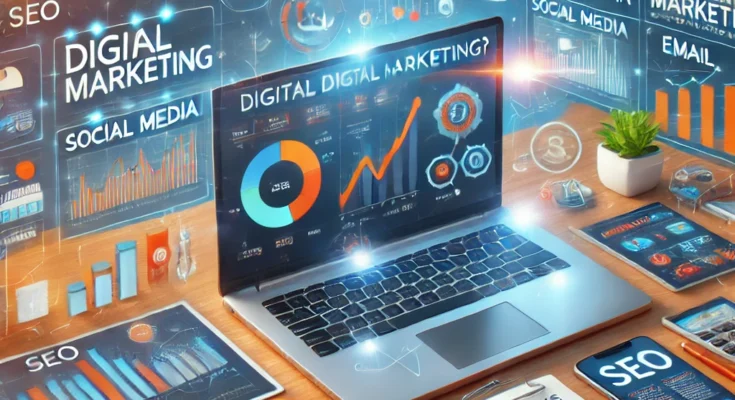Digital marketing has revolutionized the way businesses connect with their audiences. It encompasses all marketing efforts that use the internet or electronic devices to promote products or services. In this guide, we’ll explore the fundamentals of digital marketing, its various types, and how you can leverage it effectively.
Understanding Digital Marketing
Definition of Digital Marketing
Digital marketing refers to the use of digital channels such as search engines, social media, email, and websites to reach and engage customers. Unlike traditional marketing, digital marketing offers measurable results and allows for precise targeting of specific audiences.
Importance of Digital Marketing
In today’s digital age, businesses must maintain an online presence to stay competitive. Key benefits of digital marketing include:
- Wider Reach: Access global audiences with minimal effort.
- Cost-Effectiveness: Affordable compared to traditional methods like TV ads.
- Measurable Results: Track performance in real-time.
- Targeted Campaigns: Reach specific demographics based on behavior and interests.
JS SYNC (NO ADBLOCK BYPASS)
Types of Digital Marketing
Digital marketing is a multifaceted discipline. Here are the primary types:
1. Search Engine Optimization (SEO)
SEO is the process of optimizing your website to rank higher in search engine results pages (SERPs). This increases organic (non-paid) traffic to your site.
Key Elements of SEO:
- On-Page SEO: Content optimization, keywords, and meta tags.
- Off-Page SEO: Backlink building and social signals.
- Technical SEO: Improving site speed, mobile-friendliness, and crawlability.
2. Pay-Per-Click (PPC) Advertising
PPC involves paying for ads that appear on search engines or other platforms. You only pay when someone clicks on your ad.
Popular PPC Platforms:
- Google Ads
- Bing Ads
- Social Media Ads (e.g., Facebook, Instagram)
3. Content Marketing
Content marketing focuses on creating and sharing valuable content to attract and retain an audience. This includes:
- Blogs
- Videos
- Infographics
- Ebooks
4. Social Media Marketing
Using platforms like Facebook, Instagram, Twitter, LinkedIn, and TikTok to promote your brand and engage with customers.
Strategies for Social Media Marketing:
- Posting engaging content regularly.
- Running targeted ad campaigns.
- Interacting with followers to build community.
5. Email Marketing
Email marketing involves sending targeted messages to a list of subscribers to nurture leads and drive conversions.
Best Practices:
- Personalize your emails.
- Use compelling subject lines.
- Include clear calls-to-action (CTAs).
6. Affiliate Marketing
Affiliate marketing leverages third-party promoters who earn commissions for driving sales through their unique affiliate links.
7. Influencer Marketing
Collaborating with influencers to promote your products or services to their followers.
8. Mobile Marketing
Targeting users through SMS, mobile apps, or mobile-friendly websites.
How to Create a Digital Marketing Strategy
A well-thought-out digital marketing strategy ensures you achieve your business goals effectively. Follow these steps:
Step 1: Define Your Goals
Determine what you want to achieve, such as increasing website traffic, generating leads, or boosting sales.
Step 2: Know Your Audience
Identify your target audience based on demographics, behavior, and preferences. Use tools like Google Analytics for insights.
Step 3: Choose the Right Channels
Select the digital marketing channels that best align with your goals and audience.
Step 4: Create Quality Content
Content is at the core of digital marketing. Develop content that provides value, solves problems, and engages your audience.
Step 5: Implement and Optimize
Launch your campaigns and continuously monitor their performance. Use analytics tools to identify areas for improvement and optimize accordingly.
Measuring the Success of Digital Marketing
Key Performance Indicators (KPIs):
- Website Traffic: Total number of visitors.
- Conversion Rate: Percentage of visitors who take the desired action.
- Engagement Metrics: Likes, shares, and comments on social media.
- Email Open Rate: Percentage of recipients who open your email.
- Return on Investment (ROI): Revenue generated compared to campaign costs.
Tools for Analytics:
- Google Analytics: For website traffic and behavior.
- Social Media Insights: Platform-specific analytics.
- Email Marketing Software: For open rates and click-through rates.
Trends in Digital Marketing
The digital marketing landscape is constantly evolving. Here are some current trends:
1. Artificial Intelligence (AI)
AI-powered tools like chatbots and personalized recommendations are enhancing user experiences.
2. Voice Search Optimization
With the rise of smart speakers, optimizing content for voice search is becoming essential.
3. Video Marketing
Short-form videos on platforms like TikTok and Instagram Reels are dominating.
4. Interactive Content
Quizzes, polls, and interactive infographics engage users and increase retention.
Conclusion
Digital marketing is an indispensable tool for businesses in today’s technology-driven world. By understanding its various types and creating a robust strategy, you can reach your target audience effectively and achieve your business objectives. Whether you’re a small startup or an established enterprise, leveraging digital marketing will help you stay ahead in the competitive market.
Share this content:



